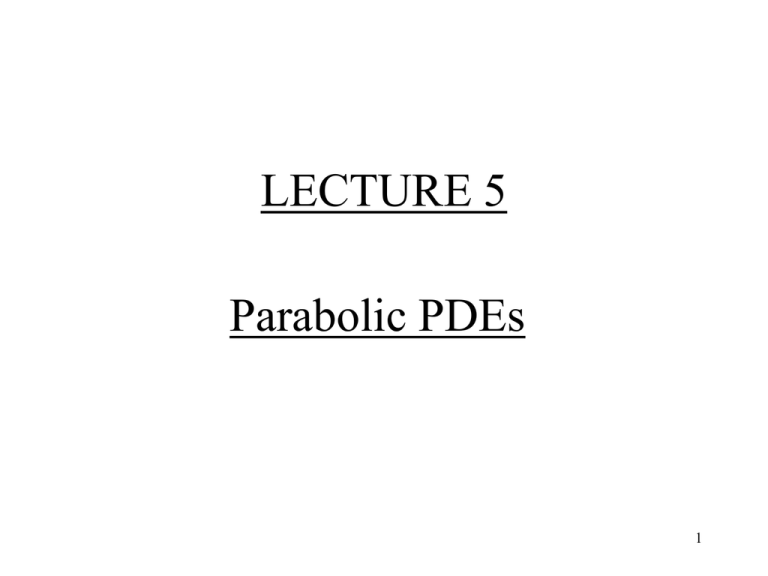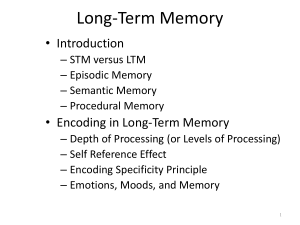05-lecture 411.50KB
advertisement

LECTURE 5 Parabolic PDEs 1 Aim of Lecture • So far in previous lectures we have discussed: – Elliptic partial differential equations - Laplace and Poisson’s Equations – Discretisation using Finite Differences – Use of Excel to solve Elliptic PDEs • This week we will discuss – Parabolic PDEs – Solution of Parabolic PDEs using Finite Difference Methods – Explicit and Implicit Methods – Solving Parabolic PDEs using Excel 2 Parabolic PDEs • General Parabolic Equation u 2u 2 f t x where t is time and u(x,t) is the dependent variable and f(x,t) is a source term. • Parabolic PDEs are evolution equations, for example, they represent phenomena that is changing in time. In this course we will only look at equations with two independent variables: space (x) and time (t). • Finite Difference Methods will be used to solve Parabolic PDEs 3 Finite Difference Method • Method based on truncated Taylor series ui 1, j ui , j u x i , j h ui , j ui 1, j u x i , j h ui 1, j ui 1, j u x i , j 2h ui 1, j 2ui , j ui 1, j 2u x 2 i , j h2 - Forward difference j+1 j j -1 i -1 - Backward difference i i+1 - Central difference - Central difference • Above approximations can be substituted for differentials in the PDE. 4 : scalar 2 u 2u 2 t x j=1 • Consider one-dimensional PDE 3 4 Finite Difference Method for Parabolic PDEs i=1 2 space 3 4 ui , j 1 ui , j u O(t ) - Forward difference in time t i , j t ui 1, j 2ui , j ui 1, j 2u 2 O( x ) - Central difference in space 2 2 x i , j x 5 Explicit Method u 2u 2 t x ui , j 1 ui , j ui 1, j 2ui , j ui 1, j x 2 t Therefore parabolic equation can be written as: ui , j 1 ui , j t ui 1, j 2ui , j ui 1, j x 2 Difference equation is: ui , j 1 ui , j r (ui 1, j 2ui , j ui 1, j ) Time (j+1) r t x 2 Time (j) SCHEME is ORDER (t, x2) 6 Example - Explicit Method Consider the following rod (length 1m) between two pieces of ice. ICE ICE The partial differential equation governing heat loss from this rod is given by u 2u 2 0 x 1 t x u (0, t ) u (1, t ) 0 u ( x,0) 2 x 0 x 0.5 u ( x,0) 2(1 x) 0.5 x 1 Boundary Conditions Initial Conditions 7 Example Use x = 0.1 and t = 0.001. Therefore r = 0.1. Also we can assume symmetry around x = 0.5. u 0 x ICE i=0 1 2 3 4 5 6 Symmetry at i=5 means that u6,j = u4,j. The finite difference approximation for each node is given by. ui, j 1 ui , j 0.1(ui 1, j 2ui, j ui 1, j ) 8 Example Use previous approximation to find changes in temperature for first ten time steps. i=0 x=0 t=0 t=0.001 t=0.002 t=0.003 t=0.004 t=0.005 . . t=0.01 . . t=0.02 1 0.1 2 0.2 3 0.3 4 0.4 5 0.5 6 0.6 0 0 0 0 0 0 0.2 0.2 0.2 0.2 0.2 0.2 0.4 0.4 0.4 0.4 0.4 0.3999 0.6 0.6 0.6 0.5996 0.5986 0.5971 0.8 0.8 0.796 0.7896 0.7818 0.7732 1 0.96 0.928 0.9016 0.8792 0.8597 0.8 0.8 0.796 0.7896 0.7818 0.7732 0 0.1996 0.3968 0.5822 0.7281 0.7867 0.7281 0 0.1938 0.3781 0.5373 0.6486 0.6891 0.6486 9 Courant Number = 1 Now let t = 0.01. Therefore r = 1. In this case the solution is unstable: . I=0 x=0 t=0 t=0.01 t=0.02 t=0.03 t=0.04 0 0 0 0 0 1 0.1 0.2 0.2 0.2 0.2 0.2 2 0.2 3 0.3 4 0.4 5 0.5 6 0.6 0.4 0.4 0.4 0.4 0.0 0.6 0.6 0.6 0.2 1.4 0.8 0.8 0.4 1.2 -1.2 1 0.6 1.0 -0.2 2.6 0.8 0.8 0.4 1.2 -1.2 10 Explicit Method • It can be shown (later lecture) that the Explicit Scheme is only stable when the Courant number (r) : 0.5x 2 r 0.5 i.e t • Therefore for a given mesh density we have a restriction on the time step size. To overcome this limitation on the time step size we use implicit methods. 11 Implicit Methods u 2u 2 t x • For explicit methods the space derivative is approximated at the previous time step. • For implicit methods the space derivative is approximated at the latest time step. • An example of an implicit method is CrankNicholson 12 Implicit Methods ui , j 1 ui , j t u 2u 2 t x ui 1, j 1 2ui , j 1 ui 1, j 1 x 2 Therefore parabolic equation can be written as: ui , j 1 r (ui 1, j 1 2ui , j 1 ui 1, j 1 ) ui , j Time (j+1) r t x 2 Time (j) • Requires Matrix Solvers. • Known as the Fully Implicit Method. SCHEME is ORDER (t, x2) 13 Implicit Method - Crank Nicholson For the explicit scheme we approximated the derivatives at (i,j) using: 2 u u 2 t x ui , j 1 ui , j t ui 1, j 2ui , j ui 1, j x 2 Central difference Forward difference Approximating the derivatives at mid-point in time (i,j+0.5) we have: 2 ui , j 1 ui , j u u 2 t x 2(0.5t ) Central difference at (i,j+0.5) 1 ui 1, j 2ui , j ui 1, j ui 1, j 1 2ui , j 1 ui 1, j 1 2 2 x x 2 Central difference Central difference at (i,j) at (i,j+1) 14 Implicit Method - Crank Nicholson Crank Nicholson in 1947 proposed the above method to allow greater time steps in their calculations. The resulting difference equation is: rui 1, j 1 (2 2r)ui, j 1rui 1, j 1 rui 1, j (2 2r)ui, j rui 1, j r t x 2 Time (j+1) Time (j) SCHEME is ORDER (t2, x2) In this case we have three unknowns on the RHS of the equation. Therefore the new value ui,j+1 is not given directly in terms of known values as is the case of the Explicit method. 15 Explicit / Implicit Comparisons i-1 i i+1 Explicit O(t, x2) j+1 j j-1 j-1 j-1 j j j+1 j+1 • Computational molecules show differences between the schemes • If there is more than one node at timestep j+1 the scheme is implicit i-1 i i+1 Crank-Nicholson O(t2, x2) i-1 i i+1 Fully Implicit O(t, x2) 16 Explicit - Implicit Methods Comparisons Explicit methods are suitable for large scale problems where the phenomena occurs quickly. For example a car crash simulation. In this case, at time t, we do not need to solve a matrix system as: ui , j 1 uij r (ui 1, j 2ui , j ui 1, j ) r t x 2 Advantage of implicit methods is that we can use larger time steps, but we also need to store and solve a matrix system.as: rui 1, j 1 (2 2r)ui, j 1rui 1, j 1 rui 1, j (2 2r)ui, j rui 1, j 17 Example Use Crank-Nicholson scheme to find system of equations for time = 0.01.Show that they give the results given in the table below. u 0 x ICE i=0 i=0 x=0 t=0 t=0.01 0 0 1 0.1 0.2 0.1989 1 2 3 4 5 6 2 0.2 3 0.3 4 0.4 5 0.5 0.4 0.3956 0.6 0.5834 0.8 0.7381 1 0.7681 6 0.6 0.8 0.7381 18 Solvers for Parabolic PDEs • Equations resulting from an explicit scheme are easy to solve as the variable at the latest time step is dependent on variables ALL at the previous time step. For example ui , j 1 uij r(ui1, j 2ui , j ui1, j ) • Equations resulting from an implicit scheme require Matrix solvers (Direct or Iterative) as the variable at the latest time also depends on unknown values at that time step. For example rui 1, j 1 (2 2r)ui, j 1rui 1, j 1 rui 1, j (2 2r)ui, j rui 1, j • For the Implicit method we can use the Gauss Seidel iterative method to solve the matrix system. 19 Excel for Solving Parabolic PDEs using Finite Difference Equations 20 USING EXCEL • Ideal for solving Finite Difference Equations i-1 i j-1 j j+1 TIME i+1 DISTANCE (X) 21 Explicit Formulation • No need for iteration. One press of F9 solves equations 22 Explicit Scheme Courant Number (r) Parameters: rr (= dt/dx^2) dx dt Time (=A25+dt) Explicit Equation D30=D29+rr*(C29-2*D29+E29) 23 Implicit Scheme • Need to use Iterative Methods • IF Command FLAG Parameter (1 or 0) – IF(CONDITION, THEN DO THIS, ELSE DO THIS) – e.g if(flag=0,0,…) Implicit Equation =if(flag=0,0,(rr*B27+(2-2*rr)*C27+rr*D27+rr*B28+rr*D28)/(2+2*rr)) [B28 & D28 are at current time-step] 24








